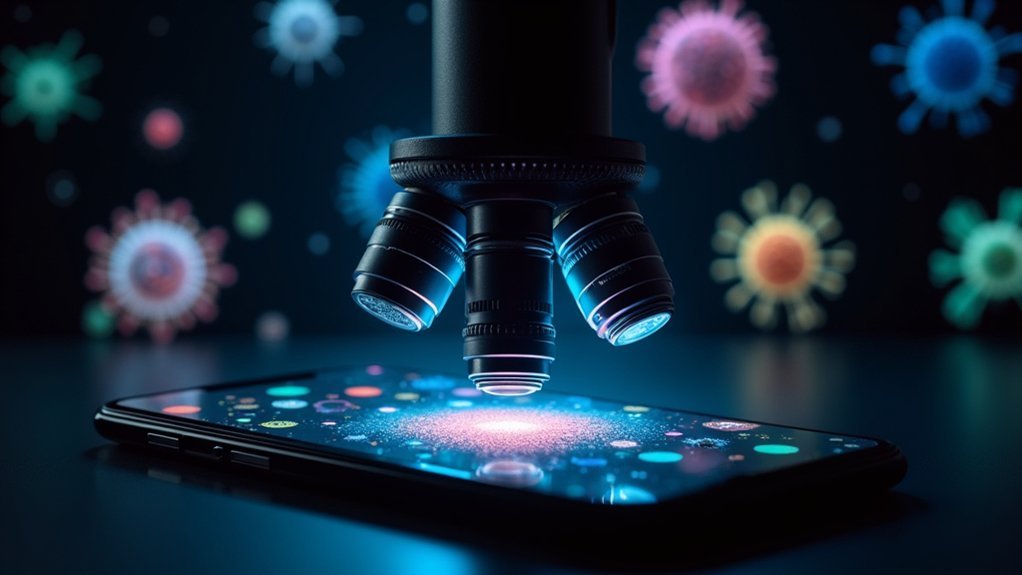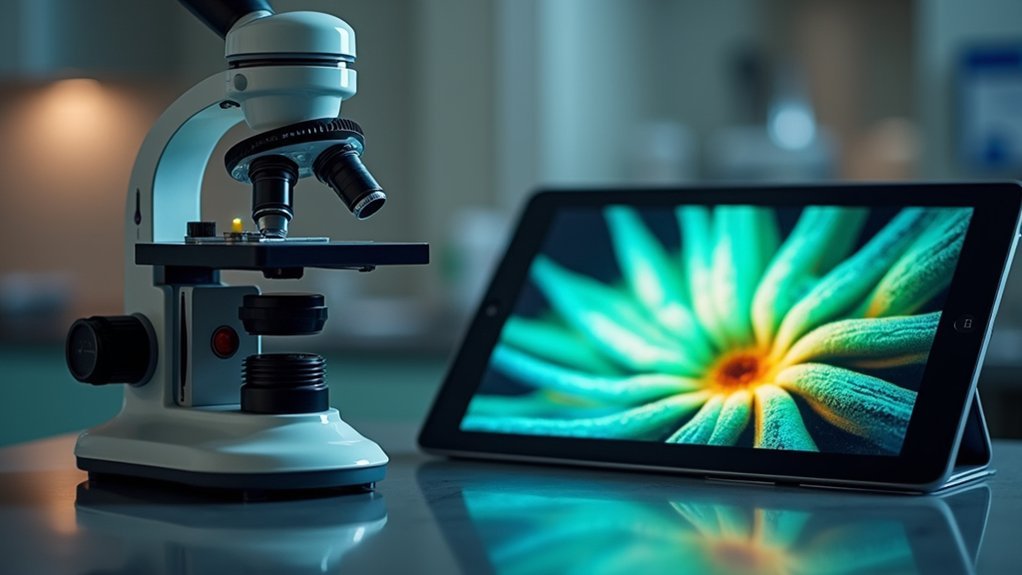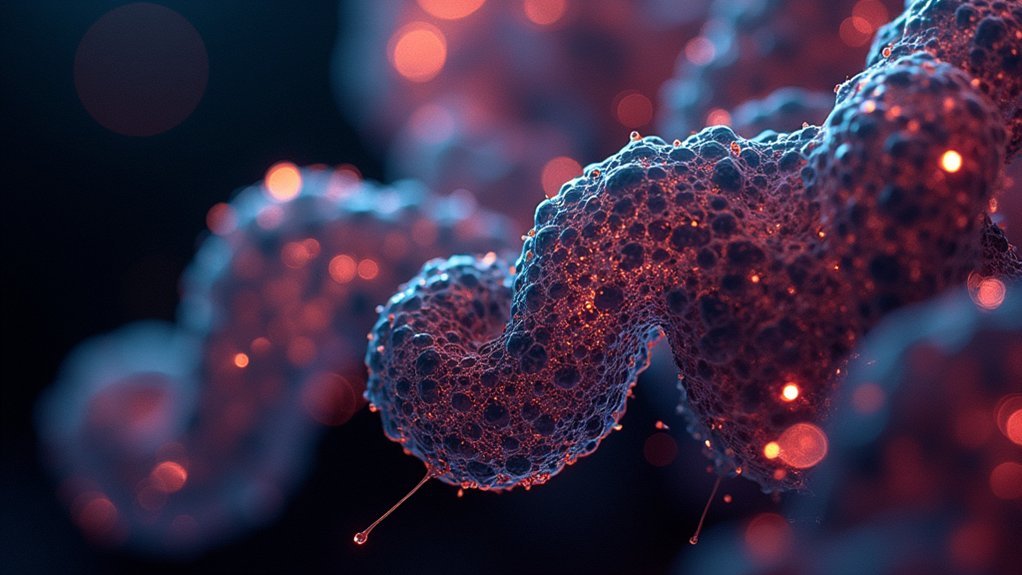You can now transform your smartphone into a powerful dark-field microscope for just $2,000—a dramatic reduction from traditional $60,000 systems. This revolutionary technology allows you to detect tuberculosis from a single drop of blood using nanoparticle color response visible through your phone. With a specialized condenser, $1 LED light, and coated slides, you’ll create high-contrast images of previously invisible pathogens. Future innovations will slash costs to under $100, making advanced diagnostics accessible worldwide.
The Revolutionary $2,000 Dark-Field Solution for Smartphone Diagnostics

A game-changing innovation from ASU Biodesign has slashed the cost of dark-field microscopy from $60,000 to just $2,000.
This breakthrough transforms your smartphone into a powerful diagnostic tool, bringing laboratory capabilities to your pocket.
The system features a specialized attachment with a condenser that optimizes the numerical aperture, allowing light to hit specimens at precise angles.
This dark-field microscopy technique creates striking contrast that reveals otherwise invisible pathogens like tuberculosis bacteria.
What makes this technology revolutionary isn’t just its price—it’s the accessibility it creates.
With specially coated slides and a single drop of blood, you’ll get diagnostic results comparable to expensive lab equipment.
Future versions aim to reduce costs even further—potentially below $100—making essential medical diagnostics available virtually anywhere.
Transforming Tuberculosis Detection With Nanoparticle Technology
You’ll marvel at how ASU’s mobile dark-field microscopy solution detects tuberculosis through a simple nanoparticle color response, requiring just one drop of blood for diagnosis.
The red color indicator, visible through your smartphone, intensifies when TB is present—offering results comparable to traditional $2,000 systems but at a fraction of the cost.
This under-$100 technology, powered by a $1 LED light, makes advanced TB diagnostics accessible in resource-limited settings where healthcare infrastructure remains scarce.
Nanoparticle Color Detection System
Revolutionary advances in nanotechnology have transformed tuberculosis detection through a simple yet powerful color-based diagnostic system. This innovative approach requires just a single drop of blood to deliver potentially life-saving results.
You’ll immediately notice the intuitive color indication—a red hue visible through your smartphone microscope signals TB presence, with higher intensity suggesting a positive diagnosis.
The system adapts dark-field microscopy to your smartphone, dramatically reducing diagnostic equipment costs from $60,000 to under $100 while maintaining comparable results to expensive desktop systems.
This accessibility breakthrough helps you detect TB early and evaluate treatment effectiveness, making quality healthcare possible in developing regions.
The smartphone-based system puts laboratory-grade diagnostic power directly in your hands, transforming how we approach infectious disease management worldwide.
Single-Drop Blood Diagnosis
By requiring just a single drop of blood serum, the nanoparticle-based diagnostic system has dramatically simplified TB detection worldwide.
You’ll find this innovative approach requires minimal sample collection, making testing faster and more efficient than traditional methods.
When using the smartphone dark-field microscopy attachment, you can identify positive TB results through a visible red color whose intensity correlates with infection presence.
This technology delivers results comparable to expensive desktop systems but at a fraction of the cost.
You’re witnessing a healthcare breakthrough particularly valuable in developing regions with limited resources.
The technology empowers communities where traditional diagnostic equipment remains inaccessible or unaffordable.
With future attachments potentially costing under $100, you’ll soon see this platform expand beyond TB to detect various infectious diseases in resource-constrained settings.
Affordable Global Healthcare Solution
While traditional dark-field microscopy systems cost around $60,000, ASU Biodesign researchers have dramatically transformed tuberculosis detection by developing a mobile technology that reduces equipment expenses to just $2,000.
You’ll find this innovation revolutionizes care in resource-limited settings by harnessing your smartphone’s camera alongside a $1 LED light source. The technology delivers diagnostic accuracy comparable to expensive conventional systems but at a fraction of the cost.
With just a single drop of blood, you can now detect TB through a nanoparticle-based assay that displays a visible red color through the smartphone attachment.
The researchers aren’t stopping there—they’re working to reduce the attachment cost to under $100 and expand the technology to diagnose multiple infectious diseases, making quality healthcare accessible worldwide.
Step-by-Step Guide to Setting Up Your Smartphone Microscope
Setting up your smartphone microscope begins with firmly attaching the dark-field accessory to guarantee perfect alignment for image capture.
You’ll need to position the $1 battery-operated LED light to create ideal illumination, allowing the specialized dark-field technique to reveal bright samples against a black background.
Prepare your samples on the coated slides designed for disease detection, ensuring proper placement for accurate color analysis when identifying conditions like tuberculosis.
Assemble the Smartphone Attachment
The assembly of your smartphone microscope attachment begins with 3-D printing the prototype designed specifically for your device. This custom-fit guarantees your smartphone will be held securely during microscopy, providing stable imaging results.
Next, attach the condenser to your printed component. This critical piece focuses light properly for dark-field microscopy, creating the distinctive dark background that makes specimens visible.
Insert the specially coated slides into the attachment’s slide reader. These coatings are designed to react with specific disease markers, enabling targeted detection capabilities.
Power your microscope with a simple $1 battery-operated LED light. Position this light source to illuminate your samples effectively against the dark background.
Finally, align your smartphone’s camera with the viewing apparatus to capture clear, analyzable images for disease identification.
Optimize Lighting Conditions
With your smartphone microscope fully assembled, proper lighting becomes your next focus for creating effective dark-field images. The $1 battery-operated LED light serves as your primary illumination source, dramatically enhancing sample visibility when positioned correctly.
For ideal results:
- Position your LED light at various angles to minimize glare and maximize the dark-field effect—experiment until you find the sweet spot.
- Adjust the distance between your phone camera and attachment until your samples appear crisp and clear.
- Secure your smartphone firmly in the attachment to prevent movement that could blur your images.
- Consider using specially coated slides designed for specific disease detection to improve contrast of infectious agents.
Fine-tuning these lighting conditions transforms ordinary smartphone images into professional-quality microscopic views with impressive clarity.
Sample Preparation Techniques
Because proper sample preparation directly impacts image quality, mastering this crucial step will greatly enhance your dark-field microscopy results.
Begin with a specially coated slide designed specifically for dark-field imaging, ensuring your sample is thin enough for ideal light transmission.
Place a single drop of the patient’s blood or specimen on the slide. This small amount provides sufficient material while maintaining clarity.
When attaching your smartphone microscope prototype, verify the condenser is correctly positioned to focus LED light onto your sample.
As you activate your phone’s camera, adjust the focus carefully to achieve maximum contrast against the black background.
Pay close attention to color variations in your sample—red intensity often indicates infection presence and severity, particularly with conditions like tuberculosis.
Enhancing Image Quality: Techniques for Perfect Dark-Field Contrast
While traditional microscopy struggles with low-contrast specimens, dark-field microscopy transforms your imaging capabilities by creating striking contrast between samples and their black backgrounds.
You’ll achieve exceptional image quality with our smartphone adaptation using just a specialized condenser and $1 LED light source.
For perfect dark-field contrast:
- Use coated slides specifically designed for targeted detection, enhancing visibility of particular pathogens
- Position your smartphone’s camera directly above the eyepiece to capture the focused illumination
- Adjust the LED light intensity to optimize contrast based on your sample type
- Monitor color intensity variations in real-time to quickly assess infection severity
This accessible technology delivers professional-grade imaging without expensive equipment, bringing laboratory-quality diagnostics to resource-limited settings worldwide.
Beyond TB: Adapting Mobile Microscopy for Multiple Infectious Diseases

The groundbreaking dark-field microscopy techniques you’ve mastered for TB detection now open doors to a much broader diagnostic landscape. With smartphone-compatible technology, you’ll soon diagnose various infectious diseases using just a single drop of blood and specially coated slides.
| Disease | Sample Type | Detection Method | Time to Result |
|---|---|---|---|
| Tuberculosis | Sputum | Nanoparticle assay | Minutes |
| Malaria | Blood | Color detection | Immediate |
| HIV | Serum | Antibody binding | < 30 minutes |
| Hepatitis | Blood drop | Protein markers | Rapid |
The system’s adaptability means you’re not limited to TB diagnostics. As manufacturers reduce costs to under $100 per attachment, you’ll bring laboratory-quality diagnostics to resource-limited settings. This technology empowers you to provide early diagnosis and treatment evaluation for multiple conditions, transforming healthcare delivery where it’s needed most.
Real-World Applications in Resource-Limited Healthcare Settings
Although traditionally confined to well-equipped laboratories, dark-field microscopy has undergone a remarkable transformation, bringing its diagnostic power directly to patients in even the most remote locations.
ASU Biodesign’s innovation has slashed costs from $60,000 to just $2,000, making advanced diagnostics accessible where they’re needed most.
Revolutionary cost reduction makes life-saving diagnostics available in underserved regions worldwide.
With your smartphone and a $1 LED light, you can now perform diagnostics that once required sophisticated equipment:
- Detect tuberculosis from a single drop of blood through visible color changes
- Evaluate treatment effectiveness in real-time, improving patient outcomes
- Achieve results comparable to expensive desktop systems at a fraction of the cost
- Support early diagnosis in areas without traditional laboratory infrastructure
The goal to further reduce attachment costs to under $100 will soon expand your diagnostic capabilities for various infectious diseases.
From Prototype to Field Use: Future Developments in Mobile Microscopy

As ASU’s innovative dark-field microscopy prototype shifts from laboratory success to practical field application, you’ll soon witness a revolution in point-of-care diagnostics.
The current $2,000 smartphone attachment dramatically reduces the $60,000 cost of traditional microscopy equipment, while leveraging simple $1 LED lighting systems.
What’s coming next is even more impressive. Developers are working to slash costs further to under $100 per unit while expanding diagnostic capabilities beyond tuberculosis.
The nanoparticle-based detection system will help you not only identify infections from a single blood drop but also assess their severity.
These advancements mean healthcare providers in developing regions will transform ordinary smartphones into powerful diagnostic tools, bringing laboratory-quality analysis to previously underserved communities.
Frequently Asked Questions
What Does Dark Field Microscopy Test For?
Dark-field microscopy tests for infectious diseases by giving you clear visualization of samples against dark backgrounds. It’s particularly effective for TB detection, where a red color in blood samples indicates presence of tuberculosis.
What Type of Organism Is Usually Visualized With a Dark Field Microscope?
You’ll typically visualize small, transparent organisms with dark-field microscopy, including bacteria like Mycobacterium tuberculosis, protozoa, yeast, and algae. It’s perfect for observing their motility and morphology against a dark background.
How to Connect a Light Microscope to a Dark Field?
To connect a light microscope to dark field, you’ll need to install a dark-field condenser, use a proper LED light source, and attach specially coated slides. Adjust the condenser positioning for best specimen illumination.
How Are Images Focused Under a Dark Field Microscope Visualized?
In dark field microscopy, you’ll see specimens appear bright against a dark background as scattered light illuminates your sample. You can visualize details through this contrast, which highlights small structures typically invisible in brightfield imaging.
In Summary
You’ve now seen how smartphone-based dark-field microscopy can revolutionize disease detection in resource-limited settings. For just $2,000, you’re equipped to diagnose tuberculosis and other infections with lab-quality precision. Don’t wait to implement this technology in your practice. As you master these techniques, you’ll transform patient care while contributing to the evolving field of mobile diagnostics.





Leave a Reply